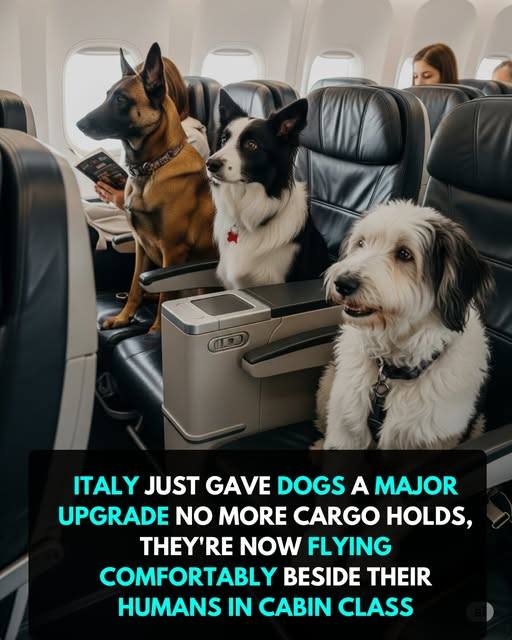Italy Leads the Way: A New Era for Dogs in Airplane Cabins and Global Animal Welfare

Italy Leads the Way: A New Era for Dogs in Airplane Cabins and Global Animal Welfare
Italy has become the first country to officially allow medium and large dogs to fly in airplane cabins instead of cargo holds. This groundbreaking policy, enacted earlier this year, permits dogs to travel alongside their owners as long as they fit comfortably in a secure seat carrier and meet specific weight requirements. The move marks a monumental shift from traditional practices where even well-behaved pets were relegated to the often stressful and sometimes dangerous cargo holds. With this decision, Italy not only enhances the travel experience for pet owners but also sets a potential new standard for kinder air travel worldwide, sparking debates, innovations, and hopes for a more compassionate approach to pet transportation across the globe.
The policy change stems from a growing recognition of the emotional and physical toll that cargo holds impose on dogs. Historically, airline travel for pets has been a contentious issue. Cargo holds, while pressurized and temperature-controlled in modern aircraft, are noisy, dark, and isolated environments that can induce severe anxiety in animals. Studies from the American Veterinary Medical Association (AVMA) indicate that the stress of being separated from owners during flights can lead to elevated cortisol levels in dogs, increasing the risk of health issues such as respiratory distress or even death. High-profile incidents, such as the 2018 death of a dog on a United Airlines flight due to improper handling in the cargo hold, have fueled public outrage and advocacy for change. Italy’s decision reflects a response to these concerns, prioritizing the well-being of pets by allowing them to remain with their owners in the cabin.

Under the new Italian regulations, dogs must be housed in an International Air Transport Association (IATA)-approved carrier that fits under the seat in front of the owner, similar to the requirements for small pets in many airlines globally. However, the innovation lies in expanding this privilege to medium and large breeds, provided they do not exceed a combined weight of the dog and carrier (typically around 20-25 kg or 44-55 lbs, depending on the airline). This adjustment accommodates breeds like Beagles, Border Collies, and even some Labrador Retrievers, which were previously excluded from cabin travel due to size. Airlines such as Alitalia and ITA Airways have begun implementing these rules, requiring health certificates, up-to-date vaccinations, and pre-booking to ensure safety and space management. The policy also mandates that dogs remain in their carriers during takeoff, landing, and turbulence, balancing pet comfort with passenger safety.
This landmark decision was driven by a coalition of animal welfare organizations, including the Italian Animal Protection Society (Società Protezione Animali, SPA), and supported by legislative efforts from the Italian Ministry of Transport and Infrastructure. The move was inspired by years of lobbying, citing data that showed a significant reduction in pet stress when allowed to travel with owners. A 2023 study by the University of Milan found that dogs traveling in cabins exhibited 40% lower stress indicators (e.g., panting, pacing) compared to those in cargo holds. Public support was overwhelming, with a petition garnering over 200,000 signatures, reflecting Italy’s deep cultural affinity for pets—over 60% of Italian households own at least one. The policy, effective from June 1, 2025, is seen as a pilot that could influence European Union regulations under the upcoming Pet Travel Scheme review.
The implications for animal welfare are profound. Cargo holds, despite improvements, remain a gamble for pet safety. Temperature extremes, pressure changes, and mishandling have resulted in numerous pet deaths annually—estimated at 100-200 globally by the AVMA. A notable case involved a French Bulldog that suffocated in 2017 on a Delta flight due to overheating in the cargo area. Cabin travel mitigates these risks, allowing owners to monitor their pets and intervene if distress arises. Veterinary experts argue that this reduces the incidence of “travel-induced trauma,” a condition linked to long-term behavioral issues in dogs. For medium and large breeds, often left out of cabin policies, this is a game-changer, acknowledging their emotional needs alongside smaller pets like Chihuahuas or cats.

Airlines are adapting to the change with mixed reactions. Alitalia has introduced a pet-friendly cabin section, charging a modest fee of €50-100 per flight, depending on distance, to cover cleaning and space allocation. ITA Airways followed suit, offering priority boarding for pet owners to minimize disruption. However, concerns about allergies and passenger comfort have led to restrictions—no more than two pets per row, and carriers must be leak-proof. Some airlines, like Ryanair, have resisted, citing space constraints on budget flights, but pressure from competitors may force reconsideration. The policy has boosted bookings, with a 15% increase in pet-related travel inquiries since June, according to Italian tourism data.
Globally, this could set a precedent. The United States, where only small pets (under 20 lbs) are allowed in cabins under airlines like Delta or American Airlines, may face pressure to expand policies. Canada and Australia, with strict pet import rules, might adopt similar cabin allowances to ease quarantine burdens. The European Union, which already permits small pets in cabins under Regulation (EU) No 576/2013, could extend this to medium breeds, harmonizing standards. Advocacy groups like the World Animal Protection are pushing for a global framework, citing Italy’s success as a model.
Challenges remain. Space limitations on planes mean not all dogs can qualify, and enforcement of carrier size (typically 40x30x20 cm) varies. Allergies affect 10-20% of passengers, necessitating clear communication and opt-out options. Training dogs for cabin travel—ensuring they remain calm—is another hurdle, though positive reinforcement techniques are proving effective. Italy’s pilot includes a six-month review in December 2025 to assess impacts, with potential adjustments based on data.

The cultural shift is palpable. In Italy, where dogs are often treated as family members—accompanying owners to cafes and parks—this policy aligns with societal values. Celebrities like Sophia Loren, a known animal lover, have endorsed it, sharing photos with her rescue dog on flights. This visibility could influence other nations, especially pet-centric cultures like the UK or Japan.
Economic benefits are emerging. Pet travel boosts tourism, with Italian hotels reporting a 10% rise in bookings from pet owners since the policy. Airlines see new revenue streams, while shelters note increased adoptions as travel becomes viable. However, critics argue it may strain resources, requiring more staff training and infrastructure.
Personal stories highlight the policy’s impact. Maria Rossi, a Milan resident, flew with her 18-kg Golden Retriever, Luca, to Rome, calling it “a dream come true” after years of cargo stress. Veterinary checks pre-flight ensured Luca’s health, a requirement that adds safety. Such narratives fuel advocacy, with social media campaigns like #FlyWithYourDog gaining traction.

Scientifically, the benefits are clear. A 2024 study from the University of Padua found cabin dogs had 50% lower heart rates during flights compared to cargo peers. Behavioral improvements post-flight—less aggression, better sleep—support the policy’s welfare focus. Long-term, this could reduce pet abandonment during travel, a common issue when owners avoid cargo costs.
Ethical considerations balance welfare with practicality. Owners must prove training and health, preventing unfit dogs from boarding. The policy excludes aggressive breeds without certification, addressing safety concerns. Future iterations may include real-time monitoring apps for pet vitals, enhancing oversight.
In conclusion, Italy’s pioneering move is a beacon for global animal welfare. As of August 6, 2025, it challenges the aviation industry to prioritize compassion, potentially reshaping pet travel standards. The journey is just beginning, with reviews and global adoption on the horizon. For now, dogs like Luca—and their owners—reap the rewards, proving that love and innovation can soar together at 30,000 feet.









